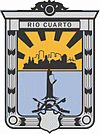Río Cuarto (Río Cuarto)
 |
 |
The Río Cuarto River flows through the province of Córdoba; its central location in the Humid Pampas favored the city's development as a transport hub for much of the surrounding agriculture, and a number of slaughterhouses and food processing plants opened in Río Cuarto during the twentieth century.
Río Cuarto was founded on November 11, 1786, as Villa de la Concepción del Río Cuarto, by the colonial Governor Rafael de Sobremonte. Its first rail connection was by way of the former Andean Railway in 1870, after which the village grew rapidly with the influx of Italian and Spanish immigrants (mainly as tenant farmers). The municipal government charter establishing the modern system of elected mayors and city council was enacted in 1883; the city's first elected mayor was Moysés Irusta.
Father Antonio Cardarelli commissioned the construction of the city's principal Roman Catholic church, the Cathedral of the Immaculate Conception, built between 1883 and 1886. The National University of Río Cuarto, established in 1971, is located here. The city's football teams include Estudiantes and Atenas. Río Cuarto hosted the International Biology Olympiad in 2006.
The city is served by National Routes 8, 36, and 158; as well as Las Higueras Airport, inaugurated in 1954. The cable-stayed Bicentennial Bridge, was inaugurated in 2010. Some of the city's principal tourist draws include the Río Cuarto Racetrack, which hosts Turismo Carretera touring car racing events; and Estancia El Durazno, an estate built in 1917 belonging to former Governor Ambrosio Olmos. The Río Cuarto craters, a group of geologically unusual impact craters, are located nearby. The city's UN/LOCODE is ARRCU.
Map - Río Cuarto (Río Cuarto)
Map
Country - Argentina
 |
 |
| Flag of Argentina | |
The earliest recorded human presence in modern-day Argentina dates back to the Paleolithic period. The Inca Empire expanded to the northwest of the country in Pre-Columbian times. The country has its roots in Spanish colonization of the region during the 16th century. Argentina rose as the successor state of the Viceroyalty of the Río de la Plata, a Spanish overseas viceroyalty founded in 1776. The declaration and fight for independence (1810–1818) was followed by an extended civil war that lasted until 1861, culminating in the country's reorganization as a federation. The country thereafter enjoyed relative peace and stability, with several waves of European immigration, mainly Italians and Spaniards, radically reshaping its cultural and demographic outlook; over 60% of the population has full or partial Italian ancestry, and Argentine culture has significant connections to Italian culture.
Currency / Language
| ISO | Currency | Symbol | Significant figures |
|---|---|---|---|
| ARS | Argentine peso | $ | 2 |
| ISO | Language |
|---|---|
| EN | English language |
| FR | French language |
| DE | German language |
| GN | Guarani language |
| IT | Italian language |
| ES | Spanish language |















